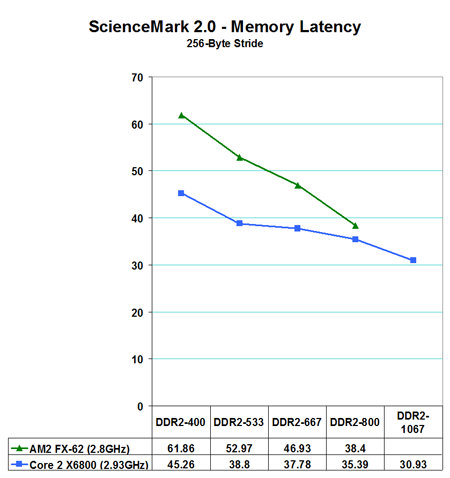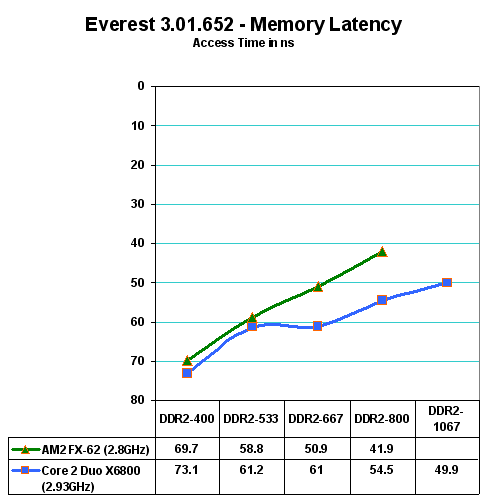A Closer Look at Latency and Scaling
As was explained in the Core 2 Duo launch review, Core 2 Duo has not physically added a memory controller on the processor. The memory controller is still part of the motherboard chipset that drives Core 2 Duo. Intel added features that perform intelligent look-aheads on the memory controller to behave like lower latency. As you saw on pages 2 and 3, ScienceMark 2.0 shows the "intelligent look-aheads" in Core 2 Duo to be extremely effective, with Core 2 Duo memory now exhibiting lower apparent latency than AM2. However, not all latency benchmarks show the same results. Everest from Lavalys shows latency improvements in the new CPU revisions, but it shows Latency more as we would expect in evaluating Conroe. For that reason, our detailed benchmarks for latency will use both Everest 1.51.195, which fully supports the Core 2 Duo processor, and ScienceMark 2.0.
Latency, or how fast memory is accessed, is not a static measurement. It varies with memory speed and generally improves (goes down) as memory speed increases. To better understand what is happening with memory accesses we first looked at Sciencemark 2.0 Latency on both AM2 and Conroe.

ScienceMark shows Conroe Latency with a 45ns to 61ns lead at DDR2-400. Latency continues to decrease as memory speed increases with Core 2 Duo, reaching a value of about 30ns at DDR2-1067. The Trend line for AM2 is steeper than Core 2 Duo, increasing at a rapid rate until latency is virtually the same at DDR2-800.
It is very interesting that ScienceMark shows lower latency on Core 2 Duo than AM2, since we all know the on-chip AM2 controller has to be faster. We thought perhaps it was because all of the tested memory accesses could be contained in the shared 4MB cache of Core 2 Duo, but Alex Goodrich,one of the authors of ScienceMark, states that Version 2 is designed to test up to 16MB of memory, forseeing the day of larger caches. In addition he states the Core 2 duo prefetcher is clever enough to pick up all the patterns ScienceMark uses to "fool" hardware prefetchers. ScienceMark plans a revision with an algoritm that is harder to fool, but Alex commented that Conroe fooling their benchmark was "in itself a great indicator of performance".

Everest uses a different algorithm for measuring Latency, and it shows the on-chip AM2 DDR2 controller in the lead at all memory speeds, with Latency almost the same at the Core 2 Duo memory speed range of DDR2-400 to DDR2-533. However, the Everest trend lines are similar to those in ScienceMark, in that AM2 latency improves at a steeper rate than Core 2 Duo as memory speed increases.
The point to the Latency discussion is that, as expected, AMD has much more opportunity for performance improvement with memory speed increases in AM2. Intel will eventually reach the point, if the lines were extended, where they would have to move to an on-chip memory controller to further improve latency. This is not to take anything away from Intel's intelligent design on Core 2 Duo. They have found a solution that fixes a performance issue without requiring an on-chip controller - for now.
As was explained in the Core 2 Duo launch review, Core 2 Duo has not physically added a memory controller on the processor. The memory controller is still part of the motherboard chipset that drives Core 2 Duo. Intel added features that perform intelligent look-aheads on the memory controller to behave like lower latency. As you saw on pages 2 and 3, ScienceMark 2.0 shows the "intelligent look-aheads" in Core 2 Duo to be extremely effective, with Core 2 Duo memory now exhibiting lower apparent latency than AM2. However, not all latency benchmarks show the same results. Everest from Lavalys shows latency improvements in the new CPU revisions, but it shows Latency more as we would expect in evaluating Conroe. For that reason, our detailed benchmarks for latency will use both Everest 1.51.195, which fully supports the Core 2 Duo processor, and ScienceMark 2.0.
Latency, or how fast memory is accessed, is not a static measurement. It varies with memory speed and generally improves (goes down) as memory speed increases. To better understand what is happening with memory accesses we first looked at Sciencemark 2.0 Latency on both AM2 and Conroe.

ScienceMark shows Conroe Latency with a 45ns to 61ns lead at DDR2-400. Latency continues to decrease as memory speed increases with Core 2 Duo, reaching a value of about 30ns at DDR2-1067. The Trend line for AM2 is steeper than Core 2 Duo, increasing at a rapid rate until latency is virtually the same at DDR2-800.
It is very interesting that ScienceMark shows lower latency on Core 2 Duo than AM2, since we all know the on-chip AM2 controller has to be faster. We thought perhaps it was because all of the tested memory accesses could be contained in the shared 4MB cache of Core 2 Duo, but Alex Goodrich,one of the authors of ScienceMark, states that Version 2 is designed to test up to 16MB of memory, forseeing the day of larger caches. In addition he states the Core 2 duo prefetcher is clever enough to pick up all the patterns ScienceMark uses to "fool" hardware prefetchers. ScienceMark plans a revision with an algoritm that is harder to fool, but Alex commented that Conroe fooling their benchmark was "in itself a great indicator of performance".

Everest uses a different algorithm for measuring Latency, and it shows the on-chip AM2 DDR2 controller in the lead at all memory speeds, with Latency almost the same at the Core 2 Duo memory speed range of DDR2-400 to DDR2-533. However, the Everest trend lines are similar to those in ScienceMark, in that AM2 latency improves at a steeper rate than Core 2 Duo as memory speed increases.
The point to the Latency discussion is that, as expected, AMD has much more opportunity for performance improvement with memory speed increases in AM2. Intel will eventually reach the point, if the lines were extended, where they would have to move to an on-chip memory controller to further improve latency. This is not to take anything away from Intel's intelligent design on Core 2 Duo. They have found a solution that fixes a performance issue without requiring an on-chip controller - for now.










118 Comments
View All Comments
Coogcheese - Tuesday, July 25, 2006 - link
Is the latency issue really due to intelligent look-ahead or the vast cache size difference between the two processors? I'd like to see a benchmark comparison between an 2MB cache opeteron and an equally cached/clocked/timed Conroe. That would settle some debate (yea, yea...wishful thinking).It could also help lend some insite to what AMD might do in the short & long term as a response as well.
The author of the review seems to give alot of credit to "look-ahead" but I found this benchmark comparison to be interesting: http://www.hexus.net/content/item.php?item=6256&am...">http://www.hexus.net/content/item.php?item=6256&am...
Opteron doesn't seem to have same problem that the Athlon does in terms of latency performance. Which could be why amd execs seem less than panicky at this point. It would allude to a market war similar to the megahurtz war that led to amd coming out with the model # system...this time it could be intel taking advantage of their capacity by laying the cache size smack down on amd instead of megahurtz.
If it is cache size and not "look-ahead" then amd could (could mind you...but would they? and how many could they?) respond much quicker I'd think. If its new technology or a combo of cache and new tech then amd will be in a much worse position imho.
Whatever the case its great for the consumer(me). Thank goodness for competition. Daddy needs a new pair of cores...and the price just got a whole lot better!
ChronoReverse - Tuesday, July 25, 2006 - link
It would indeed be very interesting to see a 2MB L2 1.6GHz Core 2 Duo E6200 compared against 2MB L2 1.6GHz Opteron 160.The shared L2 cache of the Conroe will give it a nice advantage though.
bob661 - Tuesday, July 25, 2006 - link
Anyonehave any speculation as to how much the initial Conroe's will cost? We pretty much know that the motherboards will be expensive but what about the CPU's?ChronoReverse - Tuesday, July 25, 2006 - link
The pricing has been out for a while already. They're relatively reasonable considering the performance. Only the Extreme Edition as usual is really expensive (but still not as expensive as I'd have thought).Too bad the motherboards are so expensive. I'm taking a look at that Asrock board, but I doubt it'll have any good overclocking capability.
Gary Key - Tuesday, July 25, 2006 - link
The less expensive boards for Conroe will fully hit the market near the end of August. ;-) We expect to see ECS, Foxconn, MSI, Epox, and others fully ramped up in a couple of weeks on the value boards. Until then, the Gigabyte DS3 is a really good board for overclocking the E6300/E6400 series and our Biostar and Abit boards continue to improve with each bios release. All three are under $145 now with others joining them shortly if the P965 is interesting to you. The ASRock board actually surprised us, but remember the VCore voltage cannot be adjusted. The $50~$100 market will be very interesting as the 945P, 946PL, and NV570SLI chipsets will dominate this section until the G965 boards start arriving in September if decent intergrated graphics are on your wish list, if not all of the boards will offer good performance for the money. The under $55 market will consist of VIA and SIS chipsets from PC-Chips and ASRock with a few majors like ECS and MSI having boards based on these chipsets.
Wesley Fink - Tuesday, July 25, 2006 - link
Everest Scores have been rerun with Version 3.01, which was released on July 16, 2006. Since the scores from the new version can not be compared to older Everest scores, we reran all the Everest benchmarks. 3.01 is said to provide full and complete support for Conroe and Merom. Values are different in that Memory WRITE and READ scores are reported as much higher than past Everest testing. Latency is also reported as closer between AM2 and Core 2 Duo with the 3.01 version of Everest. Charts and commentary have been revised using the new results.jjunos - Tuesday, July 25, 2006 - link
Thanks for the update wes! It always shows the quality of the website when they listen to their community and and willing to rerun all their tests in the sake of being correct! kudos!TonyB - Tuesday, July 25, 2006 - link
is it just me or did AMD just get pwned?bob661 - Tuesday, July 25, 2006 - link
I personally don't care about who owns who. I just want competition so I can get this stuff for cheap. I'm a best bang for the buck guy.goinginstyle - Tuesday, July 25, 2006 - link
Everyone benefits here with the performance improvements Intel has brought to the table and an AM2 3800+ at $150 is just an incredible value. Conroe made it easy for AMD users to upgrade their performance for very little money.